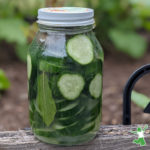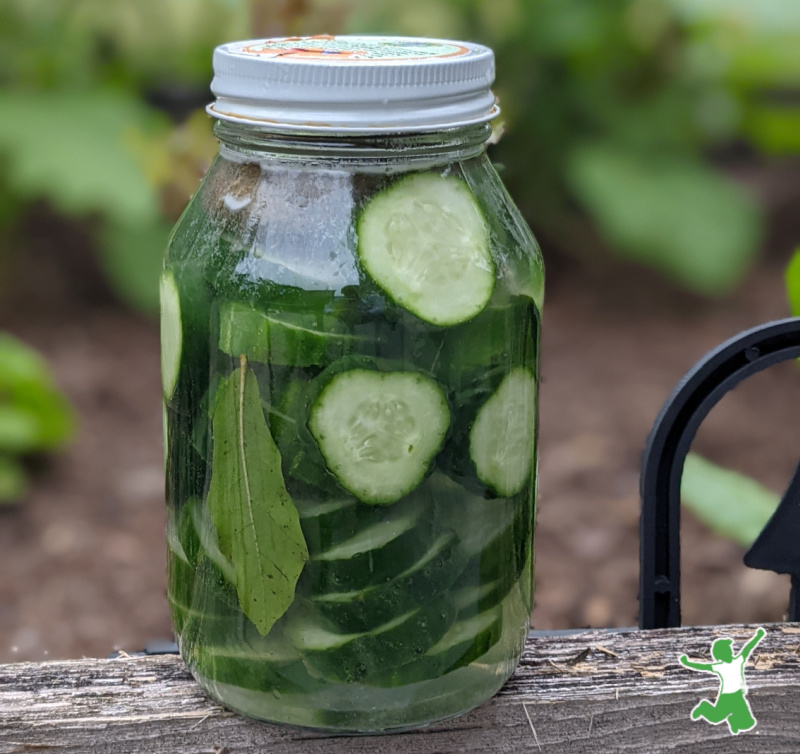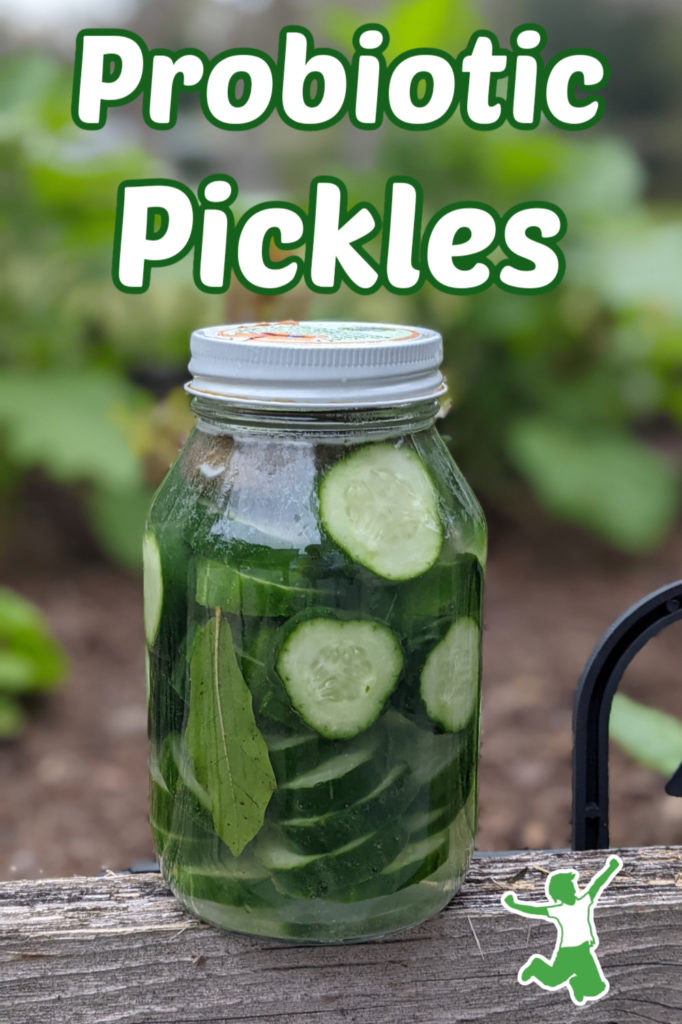Table of Contents[Hide][Show]
How to make healthy probiotic pickles the old fashioned way by fermenting sliced cucumbers in water, sea salt and a culturing medium.
When my Australian husband first moved to the United States some years ago after we first got engaged, he commented that Americans must really love pickles. No matter where you go in the United States, deli sandwiches are almost invariably served with some sort of pickle on the side.
It’s true. Americans do love pickles. Sweet pickles, sour pickles, dill pickles, it doesn’t seem to really matter what type – Americans consider them an essential condiment, and the wide variety of pickles at the supermarket is a strong testament to this fact.
The problem with store pickles is that they are for the most part a nutritionless addition to a meal.
The heat required to can pickles or seal and sterilize them in jars that can sit for months or even years on the supermarket shelf or in your pantry without going bad clinches that deal. In short, they are pickled but not fermented. Fermentation is the process whereby cucumbers are pickled without heat which adds beneficial enzymes, probiotics, and sometimes additional nutrients.
The traditional principles of fermentation can be applied to cucumbers just the same as it can to other foods like beets, apricots, tomatoes, and cabbage all of which have been the subject of previous video lessons demonstrating the health building wonders of fermentation.
Why has it taken me so long to do a video lesson on fermented cucumbers, aka real pickles, you might ask? Given their tremendous popularity as a condiment, you would think pickles would have been one of the very first fermentation videos I would have filmed.
True all around, with one very big problem. I’ve never been very good at fermented cucumbers. They always turned out soggy when I’ve made them in the past and who wants to eat soggy pickles?
But then, my friend Alex Lewin sent me a copy of his book Real Food Fermentation, and at last I learned the secret for keeping my fermented cucumbers nice and crisp as they transform into enzyme and probiotic packed pickles that easily beat any store versions in both taste and nutrition.
How to Make Healthy Probiotic Pickles
I asked Alex if I could film his fermented cucumbers, aka REAL pickes recipe as a video, and he graciously said yes, so at long last, The Healthy Home Economist does pickles!
The recipe below includes this video demonstration. If you are a more visual learner, hopefully this will give you an idea of how to make fermented cucumbers at home very easily!

Fermented Cucumbers Recipe
Recipe to culture sliced cucumbers into probiotic fermented pickles that are crisp, tasty, and healthy.
Ingredients
- 2 lbs cucumbers preferably organic, sliced across into 1/4″ pieces, cut off and discard the blossom end
- 1 quart filtered water
- 1/2 cup sauerkraut juice
- 2 Tbl sea salt
- 3-4 fresh oak leaves
- 3-5 garlic cloves peeled, preferably organic, optional
- 3-5 dried bay leaves preferably organic, optional
Instructions
-
Slice cucumbers and set aside. Be sure to discard the slice with the blossom end as this is where enzymes are located that can contribute to soggy pickles.
-
Place garlic cloves, dried bay leaves, and fresh oak, bay or grape leaves at the bottom of a clean 1/2 gallon mason jar.
-
Place sliced cucumbers on top of seasonings. Mix sea salt, liquid whey or sauerkraut juice with the quart of water (or a water/vinegar mixture if you prefer a more vinegar flavor to your pickles) into the fermentation brine water and carefully pour over the top of the cucumbers.
-
Leave fermented cucumbers on the counter for 2 days. After 2 days, remove one cucumber slice with a clean fork and taste. If it is crunchy and pleasantly sour, then refrigerate. Your pickles are done. If not, leave on the counter for another day, tasting each additional day to determine when the pickles taste pleasantly sour and are yet are still crunchy.
-
If a small bit of of foamy bubbles is on top of the brine water, it’s not a problem. Just remove it and refrigerate. If there is a lot of mold with long tendrils down into the water, the batch has not taken properly. Discard and try again using more starter and/or vinegar with your next batch and/or a fermentation weight as a preventative.
-
Properly cultured cucumbers, aka probiotic pickles, will last several months in the refrigerator.
Recipe Video
Recipe Notes
1 pint filtered water and 1 pint organic apple cider vinegar that has been boiled and cooled may be substituted for the quart of filtered water. This will result in a more commercial taste to the healthy pickles.
1/2 cup liquid whey may be substituted for the raw sauerkraut juice.
Fresh bay or grape leaves may be substituted for the fresh oak leaves.
Source
Real Food Fermentation by Alex Lewin
More Fermentation Recipes
How to Make Fermented Lemonade
How to Make Probiotic Sauerkraut










I just have to tell you! you have been so inspiring to me. I would love to have a personal dialogue with you if any possibility. We live in Indonesia full time and i am SO challenged when it comes to health over here. I have felt time and time again that i have to sacrifice my health to stay committed to living here long term, but though your blog i have had a breath of fresh air. Blessings, Marie
Another tip.
Put a cabbage leaf in the top of the jar to keep the cucumbers from floating to the top.
Love that tip!!!
@Marie Wow .. that is so cool that my blog is helping you stay healthy in Indonesia of all places .. a place I’ve never even visited (at least not YET) :))
A few pinches of organic black tea leaves works as well, if the other leaves are not available. I ferment in the Pickl-It system, and found that my pickles are super crunchy with the addition of a couple pinches of loose black tea leaves.
Thanks for mentioning that Pickl-It. I’ll have to take a closer look at the website when I have time. I’m new to pickling / fermenting, but am trying to have more options for our harvest this year.
Pickl-it jars are fine, but regular mason jars work just as well. Remember that traditional cultures didn’t have fancy fermentation vessels so no need to break the bank to get started with home fermenting. A $10 case of 6 glass 1/2 gallon mason jars is all you have to spring for to bring this healthy practice into your home.
Cheryl Ann Floystrop-Borne A combination actually 🙂 I started to research and self educate myself on nutrition to help heal my husband’s severe GERD (which has been in remission for 10+ years now ) and also to properly feed and nourish my children. We Moms don’t do it for ourselves do we? But we really should!!
oh my gosh, this post is for me! After 34 years of avoiding pickles (I’ve never liked them) I just discovered that I DO like real, fermented dill pickles. I’m just getting into the whole home fermentation thing and right now am concentrating my efforts on yogurt. In the mean time I’ve been purchasing Bubbies brand sauerkraut to start getting some fermented veggies on my plate. My toddler is so-so on the kraut but the other day when we were out to eat he was eating the pickle that came with my husband’s sandwhich. I thought, if he likes pickles I’ll buy some Bubbies fermented pickles. Since we had them I thought I may as well sample them and, wow, I like them!! I’m definately bookmarking this post for later! I’ve never wished for cucumbers in my CSA box but I hope I get tons next summer 🙂
This is fantastic, Sarah! Saving to Pinterest! BTW, did you educate yourself about nutrition solely for your children (as it states on your blog) or did someone have a health challenge in your family that could be addressed by improved nutrition?
thank you!
Would the leaves from oak trees in Tampa work?
Ciao, Pavil
Yes, that’s what I used 🙂
Wow, thanks for sharing that recipe! I had never heard those tips before. Here’s for crunchy pickles!!